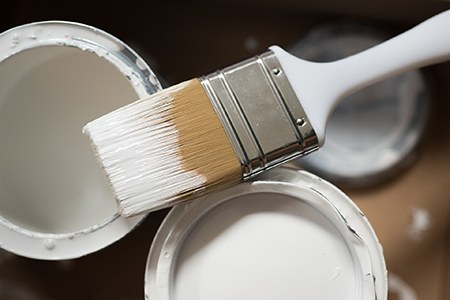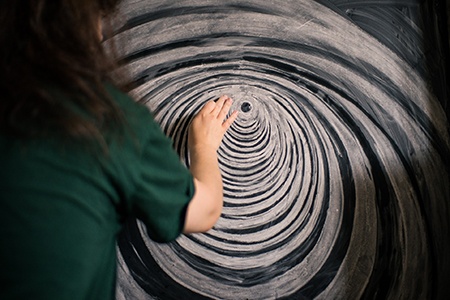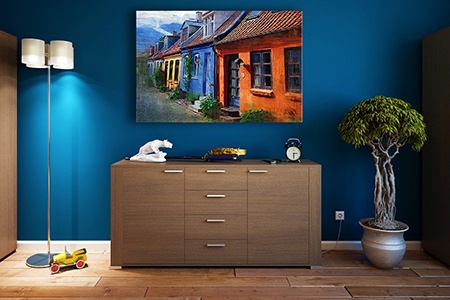24 Types of Paint & Finishes Perfect for Your Project
Author: Rick Worst | Editor: Omar Alonso
Review & Research: Jen Worst & Chris Miller

Nothing comes to mind more than colors and types of paint when people think about aesthetics. They are the perfect option when it comes to brightening up a place or adding layers of beauty to something.
However, it is not universal, and there are various paints to suit different purposes. The variations are due to compatibility with different aspects like surface, thickness, longevity, and project.
It's essential to know the different kinds of paint that are currently available. It will be highly beneficial in finding out which ones can be the ideal choice for you.
Furthermore, it will also be beneficial in making the color quality perfect, ensure it stays in place for as long as possible, and evenly covers the entire area.
24 Types of Paint
Although there are a wide variety of paints available in the current market, here is a list of some of the most common and popular ones as well as their specialties. Also take a look at the paint alternatives afterwards if you want some more ideas.
Oil Paint

Anyone who knows anything about painting is undoubtedly familiar with oil paint. It is one of the most popular types out there. There's always a question of oil-based paint vs. water-based paint when it comes to painting interior walls these days (opt for latex, which is water-based).
Some of the most famous paintings are made with it. Its base material is lead and requires application in 3 stages. It's also still one of the most popular paint types for walls.
They are primer, undercoat, and finish coat. Oil paints are renowned for their customization. You can use this color type to get a glossy or matte finish quickly. Furthermore, it works wonderfully in metallic materials.
Oil paints are more suitable for indoor use and on walls and windows. They don't work well in humid temperatures and require a long time to dry. Surfaces are easier to clean that have oil paint on them.
Enamel Paint

Enamel paints are essentially a mix between zinc or lead and varnish. Variations are one of its most unique features. You can achieve a wide array of color variations and shades with it by adding pigments.
The usual finishes that you can get from this paint are stiff and glossy that is easily cleanable. Using it is significantly convenient because of its water-resistant and chemical-proof features.
Common uses of enamel paints include interior and exterior walls, windows, flooring, stairs, and surfaces like metal and glass. As one of the types of wall paints, you may do better with an option further down the list.
It's best to have a good subcontractor at hand when using it to monitor its progress correctly. The only downside of using it is its long drying time pre-application and adding an extra titanium coating.
Cement Paint

Cement types of paint are well-known for their initial form. Unlike most variations, it's available in a powdery form. Painters have to mix it with water properly so that it can reach the right consistency.
It's base typically is white or colorful cement which is generally accompanied by pigments, additives, or accelerators.
Ideally, the perfect purpose of cement paint is to be used on both internal and external walls. Its water-resistant feature and sturdiness make it the ideal pick for use on rough and hard surfaces.
Therefore, it's the best choice for painting houses and even the worst apartments. Go for a double coating to be safe from dampening. Another thing to consider is it takes an entire day for it to dry.
Emulsion Paint

Polyvinyl acetate and polystyrene are the primary binding materials of emulsion paints, which also have cobalt and manganese as their driers.
There is a lot of room for customization with this color type. The main reason behind this ability is that it is both water-based and oil-based. Thus, you can add a plethora of pigments to it and obtain almost all kinds of colors.
Emulsion paints are a popular pick among many for their fast-drying and hardening properties. Surfaces that are colored with it are smoothly cleanable, and all you will need is water to do it.
Excellent color retention is one of the unique characteristics of this color variation. Lastly, it also has terrific sturdiness and alkali resistance.
Plastic Paint

A lot of people might not be aware of plastic paint. The main reason behind its low-key stature is that it is suitable for covering a particular niche.
Carpenters and woodworkers will really appreciate this color type. It is perfect for use on slabs, decks, showrooms, and many similar structures. Surfaces like these absorb it nicely, and the paint covers it evenly.
Although it has a very minimal repertoire, plastic paint has a versatile color palette to offer. It can cover large areas quickly and thoroughly in a matter of a few hours.
Furthermore, it has one of the best drying times, allowing it to be dependable and efficient. As far as paint types for walls go, you won't use this indoors.
Bituminous Paint

Tar and dissolved asphalt gets liquefied and turns to bituminous paint, which resembles a thick, glossier version of black. There are very few color classes that can be as adaptive as this one.
Not only is it resistant to alkali, but it also adds as a protective layer to the project it's applied on to avoid possible water damages.
One of the main issues of using bituminous types of paint is that you can't use it on anything that's going to be in an outside environment.
The main reason behind this condition is its inability to sustain under sunlight, which causes it to go through gradual deterioration. Its common uses include underwater ironworks, wooden structures, and metal pipes.
Cellulose Paint

Amyl acetate, photographic films, and celluloid sheets are some of the main components of cellulose paint.
Painters can make it more adhesive and improve its durability by adding castor oil, which results in efficient maintenance. Using it makes both the surface and the paint itself smooth for cleaning once it fully dries up.
There are many benefits to using cellulose paint. Among them, the most prominent one happens to be its fast drying properties. It establishes itself onto the surface quicker than most common alternatives.
Furthermore, it has excellent durability while also providing a warm finish. Cars and airplanes are covered with it as it is fully resistant to smoke, acids, and water.
Anti-Corrosive Paint

If you're looking for paint that can take on rough conditions and come out looking unscathed, then the anti-corrosive paint is the best option you've got.
There's no room for aesthetics with this one as it looks pitch black. However, its resistance is unparalleled due to the presence of linseed oil, zinc chrome, and fine sand.
Once you put anti-corrosive paint into something, you won't have to worry about any external factors influencing it.
Its chemical properties prevent water and air to even access the surface it covers. Therefore, it's excellent for use on metal as it prevents corrosion completely. The paint works like a blanket and thus protects the material within.
Acrylic Paint

Acrylic paints are preferred for their versatility. They're a great choice for precision brushing, water media, glazing, and staining, among other common uses. Perhaps the most noticeable aspect to acrylic types of paint are that their pigment quality and coloration is so rich and saturated.
The durability is a huge consideration, and that applies to various surfaces, like canvas, most types of drywall or drywall alternatives, watercolor paper, and more. It dries quick, can be purchased in ink bottles, tubes, and buckets due to it's varying viscosities. Acrylic is quite washable, too.
Watercolor Paint

Watercolor dries very clearly, almost translucent if it wasn't for the pigments and binder included in the solution. The most common binder used is gum-arabic to thicken and hold the pigment together.
This helps make sure the resulting product doesn't flake and peel. Despite the binder, the color pigments are suspended in the water. The water dries and evaporates, leaving behind the pigment which effectively stains the surface you're painting on.
Gouache Paint

Gouache paint is similar to watercolor paint types in that it's water soluble but it dries in a much more opaque fashion. Instead of staining the surface while letting it show through, gouache paint will cover the entire surface.
It's less shiny, too, in that it absorbs light with it's chalky substance rather than reflecting it like high-gloss paints would.
One thing to be aware of is that the paint will dry darker than it looks at first. It also takes hours to dry, which gives you the advantage of being able to continue to work and correct mistakes as you find them.
Encaustic Paint

Encaustic paint is one of the wax-based paint types. This allows it to hold a lot of color pigment, resulting in rich colors that bind tightly to the surface you're painting on. It's also moisture resistant, due to there being no solvents used in its creation.
When you use it it, you have to heat it so the wax paste softens, and you'll paint using metal tools rather than any types of paint brushes due to the thickness and viscosity of encaustic paint.
Water-Based Paint

You can include watercolor paint in this category. It's preferred over oil-based paint due to the lack of odor when painting interior surfaces. It also cleans up much easier if you have spills or mistakes. It dries quickly and wears better over time.
But that doesn't mean it's more resilient than oil-based paint options, but you'll be able to apply several coats in the same amount of time.
The real decision making question is whether or not you're willing to pay more for a more user-friendly paint that dries quicker but perhaps is less durable.
Latex Paint

Despite what people think due to it being treated as it's own paint category, latex paint is also water-based. It's a great option for exterior surfaces like whatever types of siding you have, because it can expand and contract with the temperature and it seals out moisture.
It resists the negative effects of sunlight, too, maintaining it's pigmentation and coloration. Even thought it's water-based, it's separated in discussion due to the chemicals used within it. This helps it to dry quicker than oil-based paints. A professional interior painter is typically going to opt for latex paint in the present, and you should too.
Spray Paint

You can find many of the types of paint in the spray can format. Though it's more difficult to use this for wall painting, it's a great option for furniture as an example. You can get them in many paint can sizes as well.
You definitely want to use it outdoors because of the noxious fumes that are emitted. Many opt to use masks when they paint with spray cans. The best part is how prevalent and available it is at very affordable costs, styles, and color options. Buy a bunch and store it in your garage for later since, while spray paint does expire, it takes around 15 years to do so.
Primer

Primer can come in oil or water-based options, though if you want to use in oil-based paint you should choose an oi-based primer. Otherwise you can use either types of primer paint.
Primer is used to coat your walls or surfaces before you add the typical paint you ultimately want. It prepares the walls by dulling colors that might pop through, smoothing out the entire color palette, and making it easier for the main paint to bind to the wall.
It also seals the surfaces, not only to stop discoloration from bleeding through but to help with moisture issues, etc. You'll especially want to use a primer if you're changing from a dark color paint to a lighter one.
Though there are all-in-one primer and paint combinations, many professionals don't recommend taking this shortcut. It helps you work faster but may produce a lesser quality result. Keep in mind primer comes in different grades so please pay attention.
Chalkboard Paint

This is a fun, newer option available on the consumer market. People will paint entire walls as a chalkboard, or tabletops even. It makes for a great accent wall but ultimately it ends up a dusty mess that's hard to reset all the way without really washing and scrubbing some.
Flat Paint

Flat paint has a descriptive name in that the result is very flat, meaning it doesn't reflect light and shine like glossy paints would. What's preferable beyond that is you get a lot of coverage per gallon compared to other paint types.
This is in part that it requires less coats to cover imperfections, such as sanded bumps or nail holes. If you use a flat paint, you want to make it a point not to touch the walls. It's not very durable, gets dirty easily, and even will develop stains when you try to clean it.
Eggshell Paint

Eggshell finishes are a bit more shiny than flat paints, but only slightly so. It has good coverage and hides imperfections well, too. It's even more durable than flat paint. But if you can't stand any of the lustrous shine, even a slight amount, you'll want to opt for a flat option.
Eggshell paint is a bit easier to clean but should still be used in low traffic areas where the walls aren't at as much risk of being touched or rubbed. Hallways and entryways are good options.
Matte Paint

Matte paints are kinds of paints that are very similar to flat paints, so much so that many will tell you they are the same thing. It has a very flat paint sheen. The finish is smooth and subtle with very little to no sheen at all, due to absorbing light. They have the same pros and cons as flat paints.
Satin Paint

Satin types of paint are probably the most commonly used interior paint. Due to a higher, velvety sheen, they're easier to clean, which is obviously important for rooms like bedrooms, kitchens, and living rooms. They're a great way to make your living room cozy.
Semi-Gloss Paint

Even more shiny than satin, semi-gloss paints improve on the durability and resistance to moisture and mildew. Any room that gets a lot of foot traffic and action should at least use a semi-gloss paint. They're great to use on door and window trims that get touched a lot as they're easier to clean.
Gloss Paint

Gloss paint is also called high-gloss paint to separate it from semi-gloss. It cranks everything up a notch, especially in the shininess, durability, and ease of cleaning. You can really scrub them with a soft rag if needed.
It's common to use gloss paint on trim, doors, window sills, and all types of shutters. Anything that gets touched a lot or is exposed to the outdoors some would benefit from this. But be ready to do a lot of prep work because every little bump or divot will be seen due to the reflection of the light.
Specialty Paints

I just wanted to point out that you may find paints by specific companies that don't fit in the above paint varieties. You can find paint-on stainless steel, countertop surfacing, shower and tub enclosure resurfacing paint, and more. They're painted on, but are for very specific tasks and not used in a general fashion.
Types of Paint for Every Interior & Exterior Surface
There you have it! The most popular paints are explained in detail for you!
Now that you know all about the popular paint types and their properties, you will be able to use them more efficiently. It will be easier for you to identify the compatibility of each material and which qualities will match best with them.
All that's left to do is go to the nearest hardware and purchase the kind of paint you need the most. You won't have to hire a painter ever again. Painting structures around your home and adding the right color will never seem easier!
Knowing about the types of paint is vital for understanding which kind will suit your project the best. Herein, this article explains exactly that.



